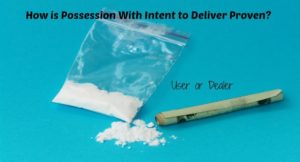How can I be charged with possession with intent to deliver when the police only found a small amount of drugs?
Felony Intent to Deliver versus Misdemeanor Personal Use
The key distinction between a misdemeanor and felony drug possession charge is the person’s intent, meaning did the person possess the drug with the intent to ingest or use it OR did the person possess the drug with the intent to deliver it to someone else. The former is a misdemeanor offense, whereas the latter is a felony charge. The quantity of the drug is a huge factor that is considered in determining whether or not a person possessed for personal use or for distribution, but quantity is only one factor. Other factors that are considered are whether or not the person  had paraphernalia related to use or paraphernalia related to distribution nearby. Did the person have bongs, rolling papers, lighters, and vaporizers, which show drug use? Or, did the person have a safe, plastic baggies, owe sheets, and a scale to show drug distribution? For example, a Penn State student was a client of JD Law and charged with a felony offense of Possession With Intent to Deliver after the Penn State police found approximately a quarter pound or 113 grams of marijuana. The officer filed the initial charge based solely upon the quantity of marijuana that was found. No evidence of delivery such as owe sheets, cash, scales, or a safe were found in the room. The client’s roommate confirmed that the client smoked but did not deal drugs. In discussions with the Centre County District Attorney’s Office, it was explained that the client had taken a “Sam’s Club” approach, meaning the client purchased a large quantity to get a better price and to avoid having to repeatedly engage in the illegal activity of buying drugs. The client’s intent was to take the marijuana home and smoke it over the entire summer. The prosecutor understood the argument and realized that the felony charge was relatively weak, so the prosecutor agreed to treat the case like a misdemeanor possession and thereby allowed ARD for the felony case.
had paraphernalia related to use or paraphernalia related to distribution nearby. Did the person have bongs, rolling papers, lighters, and vaporizers, which show drug use? Or, did the person have a safe, plastic baggies, owe sheets, and a scale to show drug distribution? For example, a Penn State student was a client of JD Law and charged with a felony offense of Possession With Intent to Deliver after the Penn State police found approximately a quarter pound or 113 grams of marijuana. The officer filed the initial charge based solely upon the quantity of marijuana that was found. No evidence of delivery such as owe sheets, cash, scales, or a safe were found in the room. The client’s roommate confirmed that the client smoked but did not deal drugs. In discussions with the Centre County District Attorney’s Office, it was explained that the client had taken a “Sam’s Club” approach, meaning the client purchased a large quantity to get a better price and to avoid having to repeatedly engage in the illegal activity of buying drugs. The client’s intent was to take the marijuana home and smoke it over the entire summer. The prosecutor understood the argument and realized that the felony charge was relatively weak, so the prosecutor agreed to treat the case like a misdemeanor possession and thereby allowed ARD for the felony case.
Who decides intent to use or intent to deliver?
The initial decision is made by the police officer, sometimes with the guidance of a prosecutor. The police are required to have probable cause to file charges, which is a relatively low threshold or evidentiary requirement. The police basically need to suspect or have a belief that someone possessed with the intent to deliver. The ultimate determiner is a jury that decides the issue at a trial. At a trial, a prosecutor must convince 12 people sitting on a jury that a person possessed drugs with the intent to deliver. Under my example above, the police officer did not support our Sam’s Club argument. If the prosecutor would have supported the officer’s charging decision and not been willing to dismiss the felony charge, that case would have gone to a trial, and a jury would have decided whether or not the client was guilty or not guilty.
It is important that you contact an experienced drug defense attorney if you have been charged with possession with intent to deliver. The attorneys at JD Law in State College have been providing representation to people charged with criminal offenses since 2004. Contact an experienced State College drug defense lawyer for a free consultation at (814) 954-7622 or via email.
